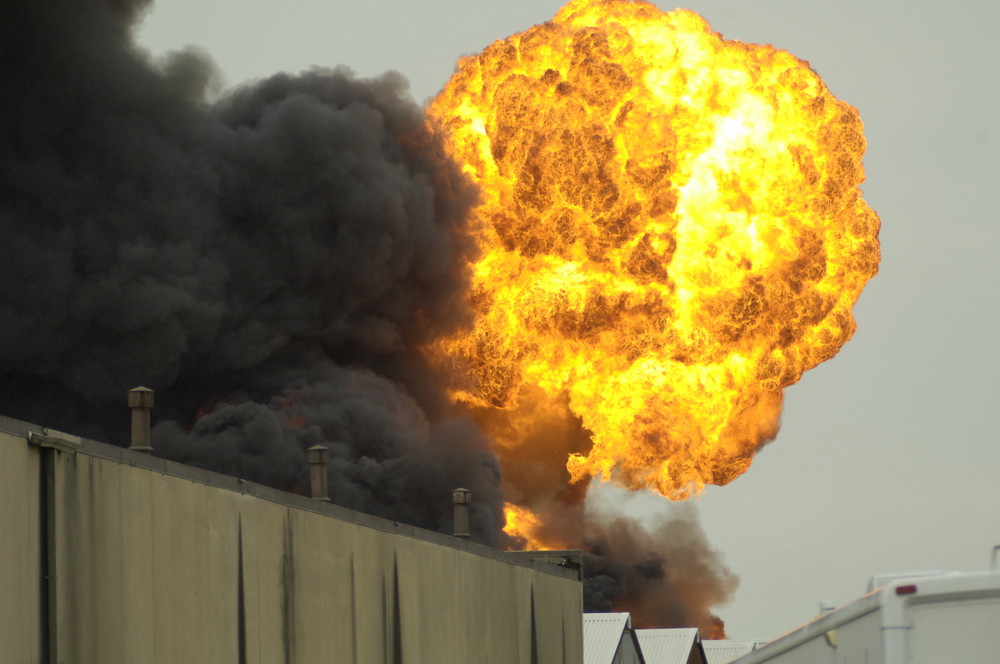Search
Hand Sanitizer Explosion Kills 2, Injures 3

Eyewitnesses saw smoke coming from the chemical plant. A few moments later, 2 workers had lost their lives – and 3 others were injured in a blast that shook the neighborhood and was heard over 2 miles away (ref 1).
- All this in the midst of Coronavirus lockdown and in a factory housing around 65 employees in which there would normally be 250.
- All this in repurposed plant, manufacturing hand sanitizer where previously other chemicals were produced.

Hand sanitizer generally contains highly flammable ethyl alcohol in concentrations up to around 62%. Clearly, then, in these times of great demand for handwash and hand sanitizer, the use of ethyl alcohol has increased globally. What’s more, many companies around the world have turned to repurposing manufacturing plant to produce hand sanitizer to meet that demand. This approach MUST INVOLVE new or revisited Process Hazard Analyses (PHA).
The rush to keep us all infection free is laudable, but this must not come at the expense of process safety. We’re pleased to note that for a few weeks now, our process safety specialists have been advising our clients on plant repurposing (Process Hazard Analysis). We advise ALL our readers, in the rush to repurpose plant for any reason, to ensure full attention is given to process safety.
Now, to the explosion incident….

In the Tarapur Chemical Zone in Palghar, Maharashtra, India at 11:30am on April 13th, smoke was detected coming out of one of the production buildings of a surfactant plant. A blast followed which was reported to have been heard 4 to 5 kilometers away (2.5 to 3 miles) – (ref 1). The incident took place on the first day that manufacturing of hand sanitizer was to begin. The blast took place inside a ‘small intermediate feed tank’ (ref 2). The affected company, in normal times, manufactures soaps, detergents and personal hygiene products at their facility. According to the Mumbai Mirror, the company had obtained the necessary permissions from the authorities to manufacture hand sanitizer in the light of increased demand caused by the Coronavirus.
At the time of writing we have no further information on the incident, so instead we talk in general terms about plant repurposing and ethyl alcohol.
The NFPA 30 classifies ethanol as a Class IB flammable liquid. It should therefore be handled and stored with great care.
As process safety consultants we are often engaged to undertake Process Hazards Analyses (PHA) on behalf of or with our clients. The process hazard analysis is, of course, a thorough, orderly, systematic approach to identifying, evaluating, and controlling the hazards of processes involving hazardous chemicals such as ethanol.
As we all know, breaking the ‘fire triangle’ – and making sure it remains broken, is one of the tenets of fire/ explosion prevention. For our case here, perhaps this can be thought of as beginning with control of ethanol releases, for example in production areas and ethanol loading areas. Equipment must be designed and arranged to prevent the unintentional escape of liquids and vapors and to minimize the quantity escaping in the event of accidental release.
Avoiding ignition sources comes next with sparks from electrical equipment and also static electricity amongst the long list of ignition sources to address, each of which has caused explosions and fires in the past.
One of the principal engineering controls for preventing electrical equipment and wiring used in ethanol production areas from constituting a source of ignition is to ensure that they are suitably rated for use (ref 3). It is formalized Hazardous (Electrical) Area Classification work that establishes where these flammable atmospheres can occur. Processing and handling areas involving ethanol vapors are referred to as Class I hazardous locations according to the National Electrical Code (NEC, NFPA 70). The classification of Hazardous Areas is something that we have recently been busy for our clients that are repurposing existing process plant for sanitizer production.
Another source of ignition is static electricity. Ignition by static electricity discharges can in part be controlled in the design and operation of equipment, by using proper bonding and grounding mechanisms, but other measures will be needed too (see for example static electricity information).
Other potential sources of ignition to consider include impact and friction sparks, welding and cutting, hot plant surfaces and more…
Using an inert gas such as nitrogen, if done correctly, is effective in reducing the potential for an ignition incident (explosion or fire) as it can make vessel head spaces incapable of supporting ignition. It breaks the fire triangle by removing the oxidant (oxygen).
There are alternative measures that provide a level of safety, but which leaves the fire triangle intact. Explosion relief venting to a safe place is used such that if an explosion were to take place, measures are in place such that people are safely located and plant is protected. Explosion protection of this type may involve open air construction, lightweight walls and roof, light weight wall panels and roof hatches, and windows of explosion venting type. In practice, explosion relief is normally used together with explosion prevention measures. Most companies will not like the idea of having an explosion in their facility, even if people and plant are protected!
It is important to ensure that critical process equipment is designed and installed correctly and operates properly through due attention to mechanical integrity. Maintaining the mechanical integrity of equipment in PSM (Process Safety Management) covered facilities will apply to equipment and systems that includes pressure vessels and storage tanks, piping systems (including piping components such as valves), relief and vent systems and devices, emergency shutdown systems, controls (including monitoring devices and sensors, alarms, and interlocks); and pumps.
Before the repurposed plant/ process is ready to operate, it will have been essential to cover all elements of operation to ensure all required safe working practices are documented and in place to operate the facility. The list of subtopics relating to safe operation is extensive and will include hot work permits, training, clear start-up and operating instructions, maintenance programs, use of contract labor and much more. Part of all this is management of change.
In the repurposing of plant to make hand sanitizer it is clear that flammable materials (including ethanol) will be used. When there is pressure of time to switch production, arising from the urgent need for hand sanitizer production, for example, we must always remember the need to give full attention to process safety. Failure to do so can turn out to be dangerous and costly.
Ref 1
Ref 2
Ref 3
OSHA Instruction TED 01-00-015

Get in touch
To learn more about our expertise and services in dust explosion prevention & mitigation, call us at +1 609 455 0001 or email us at [email protected] today.
We also offer tailored virtual and in-company process safety training programs on Dust Explosions, Static Electricity and HAC (Hazardous Area Classification) and more. Find further information here.










